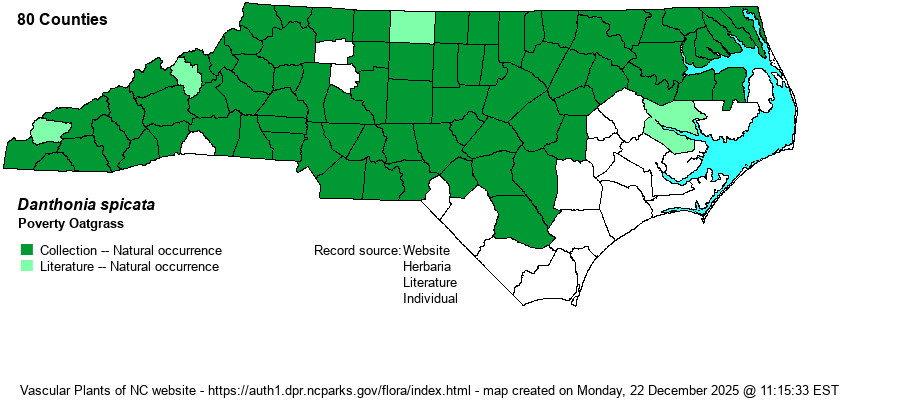| Author | (L.) Beauvois ex Roemer & J.A. Schultes | |
| Distribution | Throughout the Mountains, Piedmont, and northern Coastal Plain; extends southward along the Cape Fear River to Bladen County. Scarce in the Sandhills and absent from the southern 2/3 of the Coastal Plain.
Newf. and B.C. south to FL and NM. | |
| Abundance | Common, except rare in the Sandhills proper and absent in southern 2/3 of Coastal Plain. | |
| Habitat | Dry to mesic woodlands, forest trails and openings, rock outcrops, bluffs. In the Coastal Plain, occupies locally mineral-rich soils and/or river bluffs. This is one of the more common grasses in dry/upland woodland openings and edges. |
| Phenology | Flowering and fruiting May-August. | |
| Identification | Poverty Oatgrass is usually readily identified by its leaves that, when mature, curl and twist, and become partly to mostly straw color. Thus, the tuft of leaves at the base of the plant is what draws attention. In the Mountains, it might be confused with Flattened Oatgrass (D. compressa); see it for details. The shorter and more slender inflorescence, coupled with curled basal leaves, easily separate it from Silky Oatgrass. Early in the season (late April to mid May in Piedmont and Coastal Plain; mid May to early June in Mountains) the basal leaves have not yet curled and the inflorescence is linear, the branches not yet spread outwards; such plants resemble some species of Festuca. | |
| Taxonomic Comments | None
| |
| Other Common Name(s) | Poverty Grass | |
| State Rank | S5 | |
| Global Rank | G5 | |
| State Status | | |
| US Status | | |
| USACE-agcp | | |
| USACE-emp | | |

